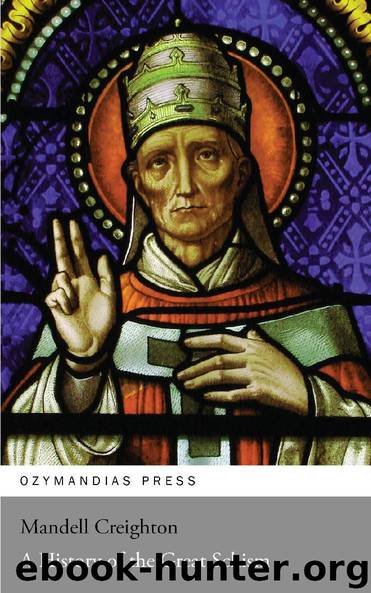A History of the Great Schism by Mandell Creighton

Author:Mandell Creighton
Language: eng
Format: epub
Publisher: Ozymandias Press
THE FLAGELLANTS
The end of the fourteenth century witnessed a profound outburst of popular devotion. The miserable condition of the Church, distracted by schism, and the disturbed state of every country in Europe, awoke a spirit of penitence and contrition at the prospect of another great Jubilee, and the opening of a new century. Bands of penitents wandered from place to place, clad in white garments : their faces, except the eyes, were covered with hoods, and on their backs they wore a red cross. They walked two and two, in solemn procession, old and young, men and women together, singing hymns of penitence, amongst which the sad strains of the “Stabat Mater” held the chief place. At times they paused and flung themselves on the ground, exclaiming “Mercy”, or “Peace”, and continued in silent prayer. All was done with order and decorum; the processions generally lasted for nine days, and the penitents during this time fasted rigorously. The movement seems to have originated in Provence, but rapidly spread through Italy. Enemies were reconciled, restitution was made for wrongs, the churches were crowded wherever the penitents, or “Bianchi”, as they were called from their dress, made their appearance. The inhabitants of one city made a pilgrimage to another and stirred up their devotion. The people of Modena went to Bologna; the Bolognese suspended all business for nine days, and walked to Imola, whence the contagion rapidly spread southwards. For the last three months of 1399 this enthusiasm lasted, and wrought marked results upon morals and religion for a time. Yet enthusiasm tended to create imposture. Crucifixes were made to sweat blood; a fanatic declared that he was the Prophet Elias, and foretold the impending destruction of the world. Crowds of men and women wandering about, and spending the night together in the open air, gave reason for suspicion of grave disorders. Boniface, like the Duke of Milan and the Venetians, as a cautious statesman in troublous times, doubted the results that might occur from any great gatherings of people for a common purpose. He was afraid lest his enemies might seize the opportunity and hatch some new plot against him. When the bands of the Bianchi reached Rome in the year of Jubilee, he discountenanced and finally dissolved them. The movement passed away; but it has left its dress as a distinctive badge to the confraternities of mercy which are familiar to the traveller in the streets of many cities of Italy.
In the Jubilee of 1400, crowds of pilgrims flocked to Rome. Although it was but ten years since the last Jubilee was celebrated, still to many pious minds the original intention of granting these indulgences at intervals of a hundred years gave a solemnity to this Jubilee which had been possessed by none since the first institution in 1300. From France especially pilgrims are said to have come in crowds. But the results of their crowding into Rome were disastrous. The plague broke out among them and spread rapidly throughout Italy.
Download
This site does not store any files on its server. We only index and link to content provided by other sites. Please contact the content providers to delete copyright contents if any and email us, we'll remove relevant links or contents immediately.
Fanny Burney by Claire Harman(26566)
Empire of the Sikhs by Patwant Singh(23026)
Out of India by Michael Foss(16824)
Leonardo da Vinci by Walter Isaacson(13239)
Small Great Things by Jodi Picoult(7076)
The Six Wives Of Henry VIII (WOMEN IN HISTORY) by Fraser Antonia(5459)
The Wind in My Hair by Masih Alinejad(5060)
A Higher Loyalty: Truth, Lies, and Leadership by James Comey(4909)
The Lonely City by Olivia Laing(4774)
The Crown by Robert Lacey(4766)
Millionaire: The Philanderer, Gambler, and Duelist Who Invented Modern Finance by Janet Gleeson(4425)
The Iron Duke by The Iron Duke(4325)
Papillon (English) by Henri Charrière(4230)
Sticky Fingers by Joe Hagan(4148)
Joan of Arc by Mary Gordon(4058)
Alive: The Story of the Andes Survivors by Piers Paul Read(3999)
Stalin by Stephen Kotkin(3922)
Aleister Crowley: The Biography by Tobias Churton(3606)
Ants Among Elephants by Sujatha Gidla(3442)
